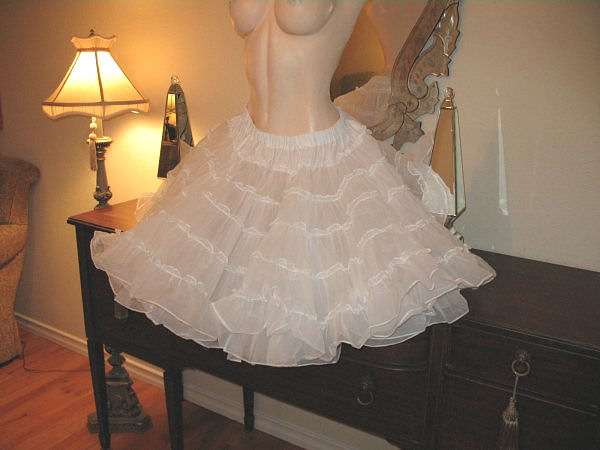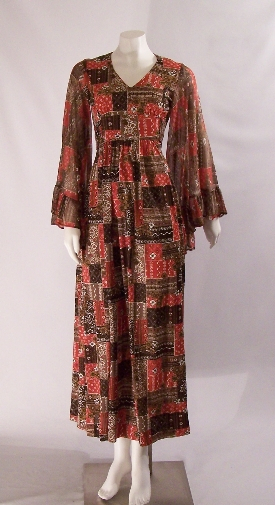I make a lot of vintage or vintage-inspired clothing for my customers. And I'm inevitably asked about undergarments. Do you really need those vintage undergarments to get the right look when wearing vintage clothing? Well, yes and no. It really depends on what your goal is.
Many of the patterns from the '50s and '60s (and some of the earlier sewing patters as well) were designed to be worn over specific undergarments. In the case of women's garments from those decades, this usually means a girls or petticoats, sometimes even both. If you're sewing a very fitted garment that is designed for use with a girdle, you may have to add more ease to both the waist and the hips. If you want the iconic look, you might want to try a girdle.
Most of the vintage patterns you'll find look perfectly find without any special underwear. In fact, you'll look more like you're wearing clothes and less like you're wearing a costume if you just wear whatever you would normally wear. If you like a push-up bra, wear it. If you hate garters, ignore them. Wear what makes you comfortable.
This is true of just about all vintage clothing, unless you want to achieve the full-skirt look. If you really want full skirts, you'll have to wear petticoats. Don't bother with the hoop skirt (they're uncomfortable and unwieldy), but do buy or make a few good-quality petticoats. Before you hit the town, however, practice wearing them around the house. Modern women aren't used to petticoats, and they do change the way you move. A few hours should be enough time to acclimate yourself to the feel and look of voluminous petticoats.
How many petticoats? That's up to you. More petticoats means a fuller skirt, but it also means you'll have more difficulty moving around. Try adding one at a time until you get the look you want.
Welcome to Aislin’s Designs—a cozy corner for crafters who love sewing, knitting, and crochet. Here you’ll find patterns, project ideas, tips, and tutorials to inspire your next handmade creation. Whether you're a beginner or seasoned maker, there's always something new to stitch, knit, or hook. Grab your yarn, thread your needle, and let’s get creative together!
Items posted on the main page are available for purchase unless otherwise indicated. If you'd like to purchase an item shown, send me a message indicating which country you live in and I'll quote you a shipping price. All payments are processed through Paypal only. If you're looking for a custom item, let me know the specifics and I'll quote you a total price. Custom items typically take 6 weeks to produce after payment is received. Keep this in mind when asking for custom orders.
Friday, January 18, 2013
Vintage Patterns: Choosing Undergarments for Your Vintage Clothing
Friday, January 11, 2013
Vintage Patterns: Finding Patterns With Particular Design Details
Vintage patterns are many and varied, just like modern patterns. And we all get comfortable with certain design details and styles. Perhaps we like the style, or we just find it easier to sew garments when we're already familiar with those particular details. But it can be difficult to find vintage patterns that use the design details you're familiar with.
This is where Vintage Pattern Wiki comes in. This is a standard wiki site, which means it can be edited by anyone, but this one focuses on vintage sewing patterns. With the ability to search patterns by era, style, manufacturer, or designer, this is probably the fastest way to find what you're looking for.
What I love is the search function. You can type in certain design elements (try typing princess seams in the search bar), and you'll come up with a variety of patterns that contain that particular element. And there are usually links to online stores where the patterns are available for purchase. You can even sign up for a wish list for patterns that are currently unavailable. This way, you'll get a nice little e-mail telling you when the pattern is available.
All in all, Vintage Pattern Wiki is an excellent site that allows you to find vintage patterns. But don't bother searching for modern sewing patterns. Nothing newer than the 1970s is listed. It's Vintage Pattern Wiki, after all.
This is where Vintage Pattern Wiki comes in. This is a standard wiki site, which means it can be edited by anyone, but this one focuses on vintage sewing patterns. With the ability to search patterns by era, style, manufacturer, or designer, this is probably the fastest way to find what you're looking for.
What I love is the search function. You can type in certain design elements (try typing princess seams in the search bar), and you'll come up with a variety of patterns that contain that particular element. And there are usually links to online stores where the patterns are available for purchase. You can even sign up for a wish list for patterns that are currently unavailable. This way, you'll get a nice little e-mail telling you when the pattern is available.
All in all, Vintage Pattern Wiki is an excellent site that allows you to find vintage patterns. But don't bother searching for modern sewing patterns. Nothing newer than the 1970s is listed. It's Vintage Pattern Wiki, after all.
Friday, January 4, 2013
Vintage Patterns: Grading Vintage Patterns
Changing a pattern to a different size is called grading. This is different from altering a pattern, as altering usually involves just a single area. Making the bust bigger or smaller to fit is altering. Changing a pattern from a size 6 to a size 10 is grading. Since vintage patterns are often smaller than today's patterns, they often require grading to fit. This process can be complex, so you should be prepared to practice a bit.
There are many different ways to grade a sewing pattern, and many vintage pattern sellers provide links to tutorials that explain grading in detail. Take a look at these different tutorials, searing for one that deals with a pattern similar to the one you will be grading. If you want a general overview of sewing pattern grading, check out Megan Nielsen Design Diary. This can help you get started, but be wary of just applying the directions given without considering your specific vintage pattern.
The first time you grade a pattern, you should use a simple sewing pattern free of complicated details. A gently sloping A-line dress is usually a good place to start, though there are other simple patterns you might want to try. Depending on the pattern itself the the exact measurements, you may be required to do either an even or an uneven grade. The difference? Quite signicant, actually. An even grade is where you add the same amount (or subtract the same amount, if you're making the pattern smaller) from the bust, waist, and hips of the pattern. For an uneven grade, each area is adjusted by a different amount to account for varying body proportions. Given that today's people are not the same as the people of 75 years ago, it's entirely possible that you'll have to do an uneven grade when working with vintage patterns. Commonly, you'll have to make the bust a great deal larger, which usually means an uneven grade.
Before you begin grading a pattern, practice with some spare fabric. You don't want to ruin a more expensive fabric until you're certain you've done everything correctly. Don't be afraid to experiment, but always practice before tackling the final project.
There are many different ways to grade a sewing pattern, and many vintage pattern sellers provide links to tutorials that explain grading in detail. Take a look at these different tutorials, searing for one that deals with a pattern similar to the one you will be grading. If you want a general overview of sewing pattern grading, check out Megan Nielsen Design Diary. This can help you get started, but be wary of just applying the directions given without considering your specific vintage pattern.
The first time you grade a pattern, you should use a simple sewing pattern free of complicated details. A gently sloping A-line dress is usually a good place to start, though there are other simple patterns you might want to try. Depending on the pattern itself the the exact measurements, you may be required to do either an even or an uneven grade. The difference? Quite signicant, actually. An even grade is where you add the same amount (or subtract the same amount, if you're making the pattern smaller) from the bust, waist, and hips of the pattern. For an uneven grade, each area is adjusted by a different amount to account for varying body proportions. Given that today's people are not the same as the people of 75 years ago, it's entirely possible that you'll have to do an uneven grade when working with vintage patterns. Commonly, you'll have to make the bust a great deal larger, which usually means an uneven grade.
Before you begin grading a pattern, practice with some spare fabric. You don't want to ruin a more expensive fabric until you're certain you've done everything correctly. Don't be afraid to experiment, but always practice before tackling the final project.
Subscribe to:
Posts (Atom)


